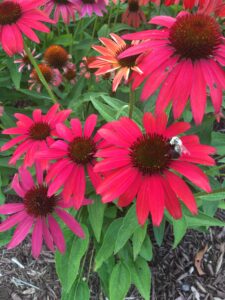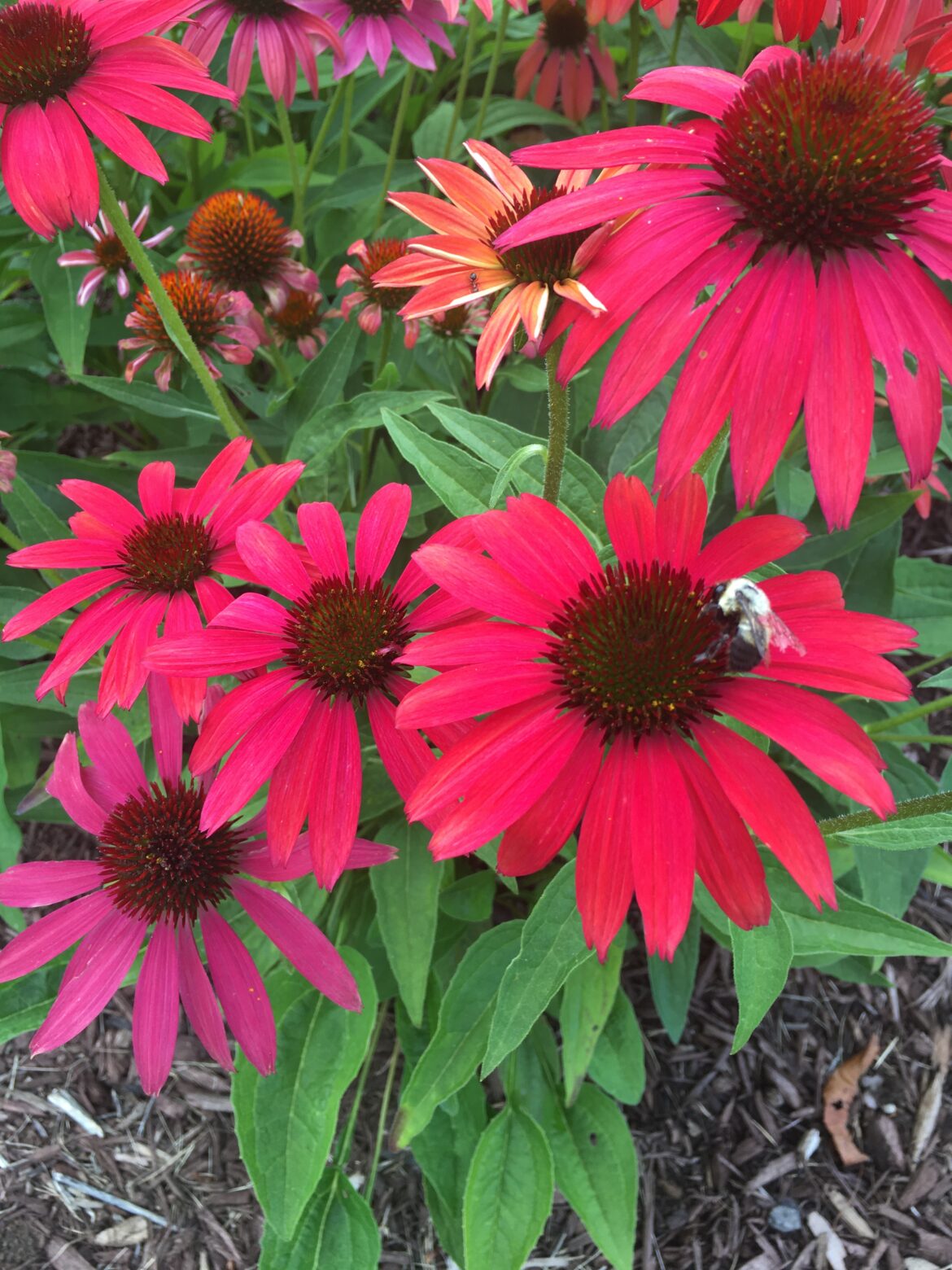July 10th
The 191st Day of the Year

Midsummer pause
between birdsong of spring and early summer
and the insect chorus of middle and Late Summer:
I wait in this quiet space
as the pull of the sun reaches its limit,
balances on the edge of this week of the year,
then breaks apart,
folds to the darkening foliage
and the fallen strata of May and June.
I look for cheer in old details,
list the history of events around me,
coming to terms with loss in its teaching:
The cycles are bound together,
closed and tight, the history says;
whatever is taken comes again;
nothing leaves or is left behind.
bf
Sunrise/set: 5:15/8:05
Day’s Length: 14 hours 50 minutes
Average High/Low: 85/64
Average Temperature: 75
Record High: 103 – 1936
Record Low: 48 – 1963
Weather
The likelihood of a high in the 90s today is 45 percent, with another 45 percent for 80s, and ten percent for 70s. The sun appears 90 percent of the days, but showers occur almost one day in two. Nights are typically warm, mild 50s occurring only once in a 15 years.
Natural Calendar
By the 10th of July, the day has shortened by 11 minutes from its summer solstice length; by the 10th of January, the day has lengthened by 12 minutes over its winter solstice length.
The correspondence between the two halves of the Yellow Springs year is tight, providing a balance that places the Earth’s orbit around the sun into a visible, tidal context of light and dark, heat and cold, Capricorn and Leo.
A phenology that measures both sides of the apparent solar and stellar tide with the effects of that tide keeps the observer in equilibrium. The sky watcher always knows both sides of the heavens: The stars of winter nights are overhead during summer days. The stars of summer nights are overhead during winter days.
Daybook
1986: Cardinal sings at 5:35 a.m., then is quiet for the rest of the morning. First woolly bear caterpillar of the season seen crossing the road near Wilberforce.
1988: Cicadas finally start to sing as the wind picks up at the bottom of a low pressure trough. Drought deepening. Alfalfa hay has doubled in price, up to $4.00 a bale. Lois is selling off lambs because of the cost of feed. Only a little stunted corn tasseling along the roadsides. Soybeans only six to nine inches high. Aspens and poplars yellowing, buckeyes along Grinnell turning red. Redbud trees wilting, some multiflora rose bush foliage all brown.
1993: First yellow coneflower completely open in the south garden. Purple coneflowers now in early bloom in the east garden. Yucca in its last days. Some lilies gone, many full flower, especially the bright yellow. First red phlox opens in the afternoon.
1997: Garlic dug today at Mrs. Bletzinger’s, 160 heads, half of them good size. Digging time about a week to ten days late, but, the heads are still tight and only touched a little with black streaks of mold. Daylilies and Asiatic/Oriental lilies are in full bloom now. The giant yellow oriental lilies by the peach tree have started to open. No cicadas yet. I found a common sooty-wing butterfly on the achillea this morning. He must have been cold because he let me count the spots on his shiny black wings.
1998: I’m feeling energized. Is it the change of color of the leaves or the scent of the air, new anticipation, a shift in the season, a hint of fall?
1999: White phlox open in the yard.
2000: Very first white phlox opened in the south garden. Teasel full bloom now on the way to Xenia, and yuccas are almost gone throughout the county. On Fairfield Pike, catalpa trees show long, green bean pods. The day was hot and humid, and, for the first time this year, the Japanese beetles finally appeared in sizable numbers all over the Virginia creeper, the roses, and the ferns. This was also the first day of the full cicada chorus.
2001: Astilbe season is done, all its pink tufts turned to seed. The heads of lizard’s tail, still white and soft a week ago, are stiff and brown. Their season was about a month; it went so quickly. First cicadas heard today.
2002: In the waterfront park at Thunder Bay, Ontario, a Yellow Springs May: Timothy still sweet to chew. Strawberries just starting. Peonies and lilacs and wild lilies in bloom. Cow parsnips flowering here and there. As we drove south towards Sault Saint Marie, purple knapweed and St. John’s wort appeared, and parsnips came into bloom. The roadsides were full of trefoil and hawkweed. Silverweed and bladder campion identified along the shore of Lake Superior.
2003: Baby robin in the back yard today.
2004: I walk out of the high sun into the dark, cool woods. It is the second week of Deep Summer, and everything is quiet and subdued in this space between the forest’s many transitions. May apples have toppled over, foliage dappled with yellow. Leafcup plants have been eaten off by deer, will bloom as they recover. Damp moss on a fallen tree glows in the twilight beneath the canopy.
A few late enchanter’s nightshade plants still have tiny blossoms, but Early Summer’s honewort is gone. Pollen has disappeared from the clustered snakeroot. Some spicebushes and privets have green berries. Touch-me-nots are tall but not budded yet. The wood nettle is still not ready to flower. Light cobwebs, not the stickier ones of the Late Summer’s micrathenas, sometimes lie across my way.
A few inches above last year’s layer of leaves, the foliage of spring’s ginger, waterleaf, and bloodroot lingers as a low, intermittent canopy, replacing the common chickweed that dominated the forest floor in spring. A lone daisy fleabane and one wilted ragwort have blossoms near a spring that crosses the path.
The shy stalks of August’s ironweed, zigzag goldenrod, white snakeroot and the small-flowered asters blend into the honeysuckles, their timing tuned by heat and the amount of sunlight to hold them until Late Summer. Two damselflies hover near the grizzled skunk cabbage. Cardinals call in the distance. Robins cluck to guide their young.
2007: Oakleaf hydrangea petals have lost most of their white. Astilbe and great blue hosta flowers all gone. Monarda late full. Our golden trumpet creeper has three flowers. First yellow summer squash picked in the garden. Cabbages starting to head up. New rhubarb is growing back around the wilted spring stalks. First large beefly seen. Ephemeral ramp blossoms have turned to seed. This evening, walking Bella, I noticed dozens of black walnuts, full size, on the ground under one of Rachel’s trees on Limestone Street; they had come down in this afternoon’s storms. Tree frog heard at about 9:30 tonight.
2008: The red-bellied woodpecker called several times this morning. A large grackle came to the feeder. The oakleaf hydrangeas are still almost completely white, and the monarda and the shy ramps are still full. Daylilies come in waves: yesterday the yellow were massed under the peach tree, today they have withered, in a day or two another resurgence. A small praying mantis on the back of Jeanie’s chair this noon; they are growing slowly.
2009: No robins this morning. Cardinal called around 5:00.
2010: At the Covered Bridge, huge swaths of violet monarda, a patch of heliopsis, scattered gray-headed coneflowers and Queen Anne’s lace, many budded ironweed. Under the canopy, St. John’s wort, old white vervain almost done blooming, honewort and avens and clustered snakeroot all to seed. In the alley, thin-leafed coneflowers are in full bloom, the tall coneflowers budded, the burdock in early bloom. More burdock seen near Antioch School – that plant in full bloom.
2011: Loud grackle fledglings calling through the morning.
2012: Only twenty-six lily varieties in bloom this morning, down ten from yesterday. One section of the red monarda is done blooming. The purple flowers of the midseason hostas are at the top of their stalks, that season closing, too. Joe Pye weed flushed. Frog croaking at 9:50 this evening.
2013: Twenty-seven varieties of lilies in bloom, up one from yesterday, the numbers (compared to last year) reflecting the effect our cool spring this year. Monarda and hostas still very strong, the character of the spring measured by the progress of the garden.
2014: Twenty-eight lilies this morning and a red admiral seen on the tall nettle plant near the primroses. At South Glen, the first teasel and the first touch-me-nots are in bloom. Most avens and honewort have gone to seed. Damselflies playing in the shade above the river slough, swift, circular randori. And a six-spotted tiger beetle flew up as I approached it along the path. Buckeye hulls are big, golden, bumpy.
2015: The yard soft and soggy from so much rain. Behind the birdsong, steady, low buzz of crickets. Fifty-two lily plants in bloom today, the most ever. The first phlox at home opened over night, along with a couple more evening primroses.
2016: Sixty-four lily plants this morning. Black walnuts full size: one clunked down on a metal roof as Jill and I walked to the end of Davis Street. And there was one ripe sweet blackberry on the corner of High and Davis.
2017: A black moth with white spots in the purple coneflower foliage this morning: Alypia ectomaculata. One hundred seventy-one day lily blossoms, five ditch lily blossoms this morning. How that compares with the plant count I have done in previous years, I really can’t say. Some of the standard purple and yellow varieties, as well as the smaller red-orange ones, are so prolific that a plant count hardly does them justice. Cabbage whites and tiny azures play among all the flowers. A family of wrens visited the back porch while I was sitting there; one of them, probably a parent, chattered aggressively at me, hopped around on the table, even knocked over a plastic flower pot in its frenzy. Tonight, abundant fireflies – their numbers seem to have held steady over the past month. More cicadas heard this afternoon, and after dark, I heard a sluggish field cricket and a steady, buzzing tree cricket.
2018: One hundred fifty-seven day lily, three Asiatic lily and a handful of ditch lily blossoms, the lily trajectory starting its descent as the garden phlox gathers momentum. A large Pandora sphinx moth at the front porch light at dawn. At eight o’clock this morning, a hackberry butterfly settled right in on the hummingbird feeder. Cabbage whites and one blue today.
2019: One hundred eighty-four day lily blossoms today, 50 ditch lilies, one tree lily. An Eastern black swallowtail swept past as Jill and I had coffee on the back porch. Then a hackberry butterfly settled on the finch feeder for a moment. A tattered red admiral came to the spiderwort.
2020: Lily count: 208 day lily, three Asiatic, 40 ditch lily blossoms today. The very first phlox and rose of Sharon flowers opened, tracking the decline of the spiderwort. Zinnias in early bloom. Two azure butterflies were playing in the high locust trees this morning. One tiger swallowtail sped by as I sat outside this afternoon. And a hummingbird moth was working the bee balm in the middle of the day. Heat wave continues, and there is no relief in the outlook. (And the full moon only seemed to make matters worse!)
May flies – locally called “Green Bay flies” – appeared suddenly tonight on Water Street, all along the river, wherever the lights shone. They flew in such numbers that they clouded every street light, and at several stores they covered the brightly lit windows in dense mats. Their short life span ended even as onlookers watched; they fell to the sidewalks by the hundreds and died there. By morning all will be dead, lying in heaps around the lamps posts.
August Derleth


